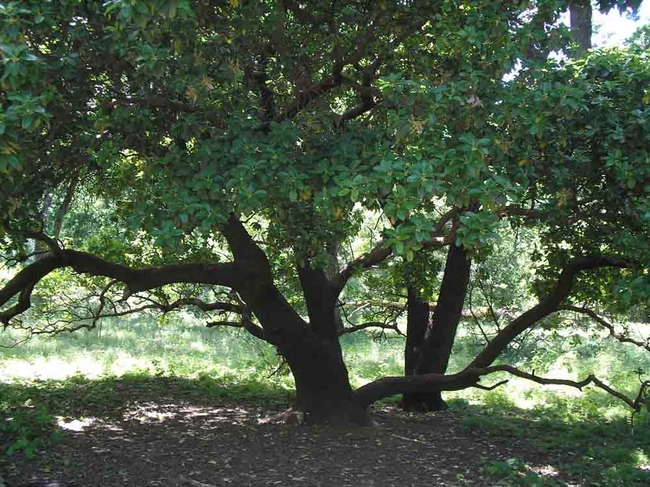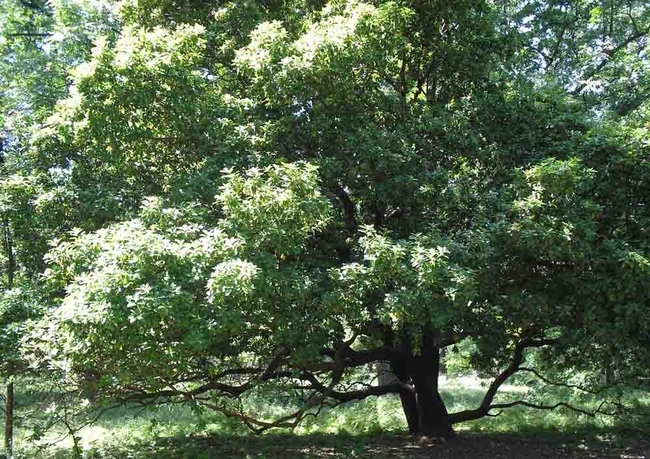A beautiful tree sits on the north side of Little Chico Creek, shading the picnic table at site #34 in Lower Bidwell Park. Its thick, smooth lower branches are perfect for climbing, and its form is both rounder and more symmetrical than its relatives at higher elevations. And its occurrence at our low altitude (elevation 197 feet) is rare.

Captain George Vancouver of the British Royal Navy commanded a voyage of exploration and diplomacy from 1791 to 1795 which circumnavigated the globe and made contact with five continents. Madrone's species name honors the Scottish surgeon, botanist and naturalist, Archibald Menzies, who noted this tree during Vancouver's voyage of exploration. Menzies, who spent many years at sea serving with the Royal Navy and on private merchant ships, recognized its similarity to the European arbutus, A. unedo, which today is a popular landscape tree in Chico. Its red fruits are shaped like strawberries, and in fact the Spanish word madroño translates as “strawberry tree.” Other common names include madroa, madroo, madroña, and bearberry.
While all parts of the Pacific madrone are remarkable, its best-known characteristic is that it freely peels its outer bark. Once this skin-like outer layer is shed, the remaining bark is smooth and polished, with a distinctive reddish color. Young bark darkens to a deep red with age; younger stems can range from green to chartreuse, and young trunks are frequently orange. Older portions of the bark become a dark, brownish red. The deep color of the bark contrasts nicely with the tree's large, glossy, dark green foliage. In spring, sprays of small, bell-shaped white flowers adorn the branches, giving way to red berries in the autumn months.

The madrone has evolved an effective method of seed regeneration: each berry contains between three and 30 seeds, and when the berries dry they develop hooked barbs that can latch onto the fur and skin of passing mammals, hitching a ride to colonize new locations.
The Pacific madrone ranges in height from about 33 to 82 feet but can reach up to 100 feet or more in ideal conditions. In those perfect conditions, it can reach a thickness of 5 to 8 feet at the trunk, much like an oak tree. Ideal conditions include a sunny site such as a south or west facing slope with soil that is well drained and lime free.
The largest known specimen of Pacific madrone lived in Joshua Creek Canyon Ecological Reserve on the Big Sur Coast. At least 125 feet tall and more than 25 feet in circumference, and listed on the American Forests National Big Tree list, it sadly was severely burned in the 2016 Soberanes Fire.
Surviving Drought and Fire: At the base of its trunk, the Pacific madrone has a woody, globe-shaped, regenerative organ known as a burl. This structure is a peculiar adaptation to its forest habitat, which historically experienced regular burns at intervals averaging between 10 and 35 years. The Pacific madrone is susceptible to fire, but also relies on fire to regenerate. Its low resistance to fire is due to its thin bark. Conversely, repeated top-kill by fire encourages burl development, enhancing Pacific madrone survival - the burl serves as a source of stored carbohydrates for prolific postfire sprouts. These rise from dormant buds on the burl, and initially grow rapidly after a fire.
A massive, wide-spreading root system increases its ability to withstand summer drought. In fact, the tree prefers dry, well-draining soils and does not tolerate direct watering during the summer months. Once established, Pacific madrone is windfirm, drought enduring, and somewhat tolerant of wet, freezing conditions.
Native American Uses: The Concow tribe calls the tree dis-t?'-tsi or kou-wät′-chu. Native Americans sometimes ate the berries, but were more likely to make them into a type of cider, or chewed them to cleanse their mouths, since the berries' high tannin content makes them astringent. Madrone berries were used in necklaces and other decorations, and as bait for fishing. Tea made from the bark and leaves was used to treat stomach aches, cramps, skin ailments, and sore throats. The wood was used to make implements and it was particularly useful as firewood; its density and hardness ensures it burns long and hot -- even better than oak.
Pacific madrone is a particularly beautiful tree, with its reddish curved trunks supporting a broad, spreading crown of deep green leaves. It is most often seen as a single specimen tree displaying its finery among the more common Douglas fir and tanoak. It is currently declining throughout most of its range, unfortunately due to 100 years of forest fire control and urban development in its native habitat. We are lucky to have our lovely, rare specimen in Lower Bidwell Park.
UC Master Gardeners of Butte County are part of the University of California Cooperative Extension (UCCE) system. To learn more about us and our upcoming events, and for help with gardening in our area visit our website. If you have a gardening question or problem, email the Hotline at mgbutte@ucanr.edu or leave a phone message on our Hotline at 530-552-5812. To speak to a Master Gardener about a gardening issue, or to drop by the MG office during Hotline hours, see the most current information on our Ask Us section of our website.